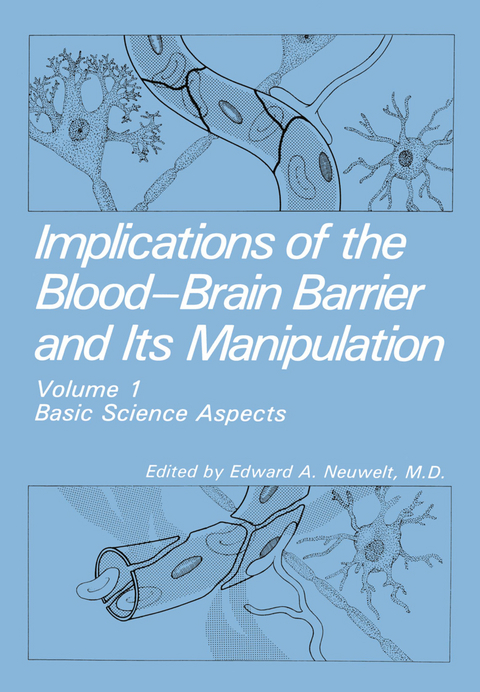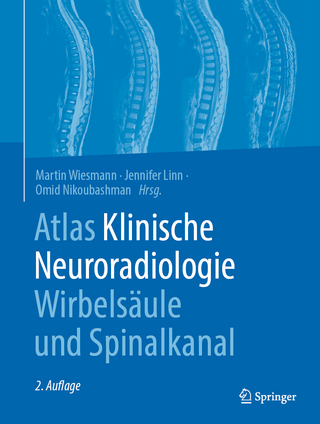
Implications of the Blood-Brain Barrier and Its Manipulation
Springer-Verlag New York Inc.
978-1-4612-8039-2 (ISBN)
1. The Challenge of the Blood-Brain Barrier.- 1. Introduction.- 2. Do Monocytes Stream across the Blood-Brain Barrier in Response to Brain Injury?.- 3. Effects of Injury to the Blood-Brain Barrier by Mass Lesions in the CNS: Neuroradiologic Characteristics.- 4. Encephalopathy Associated with Cryoprecipitable Australia Antigen.- 5. Adoptive Immunotherapy as a Means to Circumvent the Blood-Brain Barrier and the Immunologic Privilege of the CNS.- 6. The Dramatic Effect of Corticosteroids on Vasogenic Cerebral Edema.- 7. The Role of Blood-Brain Barrier Modification in the Treatment of Primary Brain Tumors.- 8. Competition at the Blood-Brain Barrier by Dietary Amino Acids Causing Fluctuations in the Motor Performance of Patients with Parkinson Disease Who Are Receiving Levodopa Therapy.- 9. Conclusion.- References.- 2. History of the Blood-Brain Barrier Concept.- 1. Studies with Dyestuffs.- 2. The Stern-Gautier Hypothesis.- 3. Selectivity of the Barrier.- 4. Lipid Solubility.- 5. Sink Action of the Cerebrospinal Fluid.- 6. Morphology of the Blood-Brain Barrier.- 6.1. Brain Capillary Endothelial Cell End-Feet.- 6.2. Electron Microscopists’ Heresy.- 7. The Extracellular Space of the Brain.- 8. The Barriers and Homeostasis.- 8.1. Brain Extracellular Fluid.- 8.2. Cerebral Edema.- 9. Ontogeny of the Blood-Brain Barrier.- 9.1. Rate of Protein Exchange.- 9.2. Concentrations of Individual Proteins.- 10. Comparative Aspects.- 10.1. Elasmobranchs.- 10.2. Holocephalans.- 10.3. Cyclostomes.- 10.4. The Invertebrate Barrier.- 10.5. Value of Comparative Studies.- 11. The Present Era.- 11.1. Perfused Brain.- 11.2. Isolated Choroid Plexus.- 11.3. Isolated Brain Microvessels.- 12. Summary.- References.- 3. The Anatomic Basis of the Blood-Brain Barrier.- 1. Intercellular Tight Junctions.-1.1. Structure and Permeability.- 1.2. Glial Modulation.- 2. Pits, Vesicles, and Channels.- 2.1. Vesicle Translocation.- 2.2. Most Vesicles May Be Pits.- 2.3. Vesicle Fusion and Fission.- 2.4. Cryofixation and Chemical Fixation.- 3. Receptors.- 3.1. Insulin.- 3.2. Low-Density Lipoprotein.- 3.3. Transferrin.- 4. Electric Charge.- 4.1. Charge and Endocytosis.- 4.2. Charge and Lectin Binding.- 5. Circumventing the Barrier.- 5.1. Retrograde Axonal Transport.- 5.2. Endothelial Alteration.- 5.3. Transplants.- 6. Extravascular Spread of Peroxidase.- 6.1. Perivascular Basement Membrane.- 6.2. Interstitial Compartment.- 6.3. Clearance via Basement Membranes.- 7. Enzymes.- 8. Conclusions.- References.- 4. Quantitation of Blood-Brain Barrier Permeability.- 1. Introduction.- 2. Two Methodologic Approaches.- 3. Continuous Uptake.- 3.1. Intravenous Administration.- 3.2. Brain-Perfusion Technique.- 4. Single-Pass Uptake.- 4.1. Indicator Diffusion.- 4.2. Brain Uptake Index.- 4.3. Single Injection-External Registration.- 5. Summary.- References.- 5. Transport across the Blood-Brain Barrier.- 1. Physicochemical Factors Influencing Permeability.- 1.1. Solute Transport.- 1.2. Water.- 1.3. Influence of Protein Binding.- 1.4. Convection in Cerebral Interstitial Fluid.- 2. Specific Transport.- 2.1. Monosaccharides.- 2.2. Monocarboxylic Acids.- 2.3. Amino Acids.- 2.4. Vitamins, Cofactors, and Nucleic Acid Precursors.- 2.5. Peptides.- 3. Factors Modifying Permeability.- 3.1. Blood Flow and Permeability.- 3.2. Modulation of Transport Mechanisms.- 4. Conclusions.- References.- 6. Pharmacology of the Blood-Brain Barrier.- 1. Introduction.- 2. Methods of Measuring Drug Transfer.- 3. Capillary Transport Models and PS Products.- 4. Mechanisms of Transport to and through the BBB.- 5. Local Differences in Influx.- 6. Drug Permeability and Distribution.- 7. Summary.- References.- 7. Ontogeny and Phytogeny of the Blood-Brain Barrier.- 1. Introduction.- 2. Ontogenetic and Phylogenetic Animal Models of Barriers.- 3. Structural Configurations of Barrier Systems in Infant Mammals.- 3.1. Blood-Brain Barrier.- 3.2. Blood-CSF Barrier: Choroid Plexus.- 4. Quantitation of Solute Permeation into CNS.- 5. Physiologic Factors Affecting Solute Permeation into CNS.- 5.1. Cerebrovascular Variables.- 5.2. Extracellular Fluid Volume.- 5.3. Cerebrospinal Fluid Sink Action.- 5.4. Brain Cell Metabolism.- 5.5. Macromolecular Composition of CSF, Cells, and Plasma.- 5.6. Acid-Base Effects.- 6. Perinatal Development of Barriers Regulating Solute Movement.- 6.1. Anions.- 6.2. Cations.- 6.3. Nonelectrolytes.- 6.4. Sugars.- 6.5. Amino Acids.- 6.6. Monocarboxylic Acids.- 6.7. Monoamine Neurotransmitters.- 7. Discussion of Ontogeny of Barrier Function in Mammals.- 7.1. Ontogeny of the BBB: Models and Questions.- 7.2. Permeability of the BBB in Infant Rats in in Vivo Experiments.- 7.3. Regional Differences in Barrier Permeability in the Developing CNS.- 7.4. Cation versus Anion and Nonelectrolyte Permeation.- 7.5. Anatomic Substrates for More Permeable Interfaces.- 7.6. Developmental Permeability: Neural versus Peripheral Tissues.- 7.7. Kinetic Constants for Carrier Transport in Immature Brain.- 7.8. Interpretation of BUI Constants for Infants.- 7.9. CNS Hemodynamic and Hydrodynamic Development.- 7.10. Ontogeny of Acid-Base Modulation of Transport.- 7.11. Pharmacologic and Toxicologic Considerations.- 7.12. Pathophysiology of the Developing Barriers.- 7.13. The Rat as an Ontogenetic BBB Model.- 7.14. Future Research Directions.- 8. Recapitulation and Perspective.- References.- 8. The Blood-Nerve Barrier and the Pathologic Significance of Nerve Edema.- 1. Introduction.- 1.2. The Blood-Nerve Barrier and the Endoneurial Compartment.- 2. Endoneurial Fluid Pressure.- 2.1. Mechanisms of Increased Endoneurial Fluid Pressure.- 3. Significance of Endoneurial Edema.- 3.1. Topography of Endoneurial Edema.- 3.2. Impact of Endoneurial Edema.- 4. Nerve Fiber Lesions Associated with Increased EFP.- 4.1. Wallerian Degeneration Secondary to Nerve Crush.- 4.2. Cryoprobe Injury.- 4.3. Chemical Injury.- 4.4. Laser Injury.- 4.5. Entrapment Neuropathy.- 4.6. Secondary Axonal Injury.- 5. Summary.- References.- 9. Potential for Pharmacologic Manipulation of the Blood-Cerebrospinal Fluid Barrier.- 1. Introduction.- 2. Consideration of Gross Structure.- 3. Barrier Cells: Plexus Epithelium versus Cerebral Endothelium.- 4. Polarity of Membranes in CNS Transport Interfaces.- 5. Experimental Preparations of Choroid Plexus.- 5.1. In Vitro.- 5.2. In Situ.- 6. In Vivo Analyses of Choroid Plexus-CSF Systems.- 7. Rate-Limiting Step in Transchoroidal Transport.- 8. Permeability of Tight Junctions and Membrane Poles.- 8.1. Tight Junctions.- 8.2. Basolateral Membrane.- 8.3. Apical Membrane.- 9. Carrier Transport Systems in Choroid Plexus.- 10. Exploitation of Barrier Transport Mechanisms in the Blood-CSF Barrier.- 10.1. Ascorbic Acid.- 10.2. Nucleosides and Vitamins.- 10.3. Purines.- 10.4. Amino Acids.- 11. Transcellular and Paracellular Transport of Proteins.- 11.1. Endothelial Vesicular Transport: Blood-Brain Barrier versus CP.- 11.2. Transcellular Pathway (into or through Epithelium).- 11.3. Paracellular Pathway (between Epithelia).- 11.4. Factors Affecting CSF Protein Concentration.- 11.5. Therapeutic Strategies.- 12. Polypeptide Receptors and Transport.- 12.1. Oligopeptides.- 12.2. Enkephalins.- 12.3. Polypeptide Hormones.- 13. Prostaglandins and Leukotrienes.- 14. Neurotransmitters.- 15. Altered Fluxes of Inorganic Ions across Choroid Plexus.- 15.1. Sodium and Chloride.- 15.2. Bicarbonate.- 15.3. Potassium.- 15.4. Lithium.- 15.5. Calcium and Magnesium.- 16. Hypertensive and Osmotic Opening of the Choroid Plexus.- 17. Future Outlook and Practical Considerations.- References.- 10. The Blood-Brain Barrier and the Immune System.- 1. Basic Concepts of Immunology.- 2. Is the Central Nervous System an Immunologically Privileged Site?.- 3. Cerebrospinal Fluid Composition.- 4. Circulating Antibodies in Neurologic Disease.- 5. Demyelinating Diseases of the Central Nervous System.- 6. Neoplastic Disease of the Central Nervous System.- 7. Is There a Separate Immune System in the Central Nervous System?.- 8. Therapeutic Implications of the Blood-Brain Barrier.- 9. Summary and Conclusions.- References.- 11. Cerebral Edema and the Blood-Brain Barrier.- 1. Introduction.- 1.1. Definition of Edema.- 1.2. Types of Cerebral Edema.- 2. Development and Resolution of Vasogenic Edema.- 2.1. Formation and Spread of Vasogenic Edema.- 2.2. Equilibrium Phase.- 2.3. Resolution of Vasogenic Edema.- 2.4. Chemical Characteristics.- 3. Characteristics and Reversibility of Ischemic Edema.- 3.1. Ischemic Changes.- 3.2. Postischemic Edema.- 3.3. Delayed Breakdown of the Blood-Brain Barrier.- 4. Functional Disturbances in Injured Brain May Not Be Related to Cerebral Edema.- 5. Conclusion.- 6. Summary.- References.- 12. Drug Delivery to the Brain by Blood-Brain Barrier Circumvention and Drug Modification.- 1. Introduction.- 2. Factors Influencing Drug Concentrations in Brain.- 2.1. Influence of Physicochemical Properties on Drug Organ Uptake.- 2.2. Drug Interactions with Plasma Proteins.- 3. Optimization of Drug Uptake by Brain.- 3.1. Frequency of Drug Administration.- 3.2. Route of Drug Administration.- 4. Reversible Blood-Brain Barrier Modification.- 4.1. Osmotic Opening.- 4.2. Metrazol Opening.- 4.3. Miscellaneous Techniques.- 5. Chemical Modification of Drugs.- 5.1. Analogues.- 5.2. Prodrugs.- 5.3. Carrier-Mediated Transport at the Blood-Brain Barrier.- 6. Cerebral Blood Flow.- 7. Conclusions.- References.- 13. The Blood-Ocular Barrier.- 1. Blood-Aqueous Barrier.- 2. Blood-Retinal Barrier.- References.
| Erscheint lt. Verlag | 13.10.2011 |
|---|---|
| Zusatzinfo | 79 Illustrations, black and white; 434 p. 79 illus. |
| Verlagsort | New York, NY |
| Sprache | englisch |
| Maße | 170 x 244 mm |
| Themenwelt | Medizinische Fachgebiete ► Chirurgie ► Neurochirurgie |
| Medizin / Pharmazie ► Medizinische Fachgebiete ► Neurologie | |
| Naturwissenschaften ► Biologie ► Humanbiologie | |
| Naturwissenschaften ► Biologie ► Zoologie | |
| Schlagworte | brain • Brain Injury • brain tumor • central nervous system • nervous system • Parkinson • pathophysiology • Physiology • Tumor |
| ISBN-10 | 1-4612-8039-7 / 1461280397 |
| ISBN-13 | 978-1-4612-8039-2 / 9781461280392 |
| Zustand | Neuware |
| Informationen gemäß Produktsicherheitsverordnung (GPSR) | |
| Haben Sie eine Frage zum Produkt? |
aus dem Bereich


